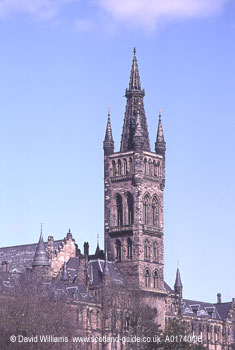While large-scale urban renewal was taking place in the second half of the nineteenth century (predominantly in and around the city`s historic centre) the newly developed western area had already become the new administrative and commercial centre. Many examples of fine Victorian architecture were erected, the most significant of which was the City Chambers (1882-90, William Young), the rich and imposing exterior of which was matched by the lavish interior which features two quite outstanding marble staircases.
As time went on, the well-to-do moved even farther west (maintaining a comfortable distance from the squalor of the city centre and Clydeside) and large-scale planned developments were undertaken, the most notable of which was that on Woodlands Hill which was designed by Charles Wilson in the 1850s.
The transfer of Glasgow University (see picture) to Gilmorehill in the 1860s and the subsequent erection of its substantial buildings by Sir George Gilbert Scott and his son J. Oldrid Scott then established the West End as the most prosperous area of the city. Some of the district`s spectacular terraces, such as Alexander `Greek` Thomson`s Great Western Terrace (1869), rank among Glasgow`s finest examples of very expensive middle-class housing.
This article is based on the guidebook "The Glasgow Guide".
